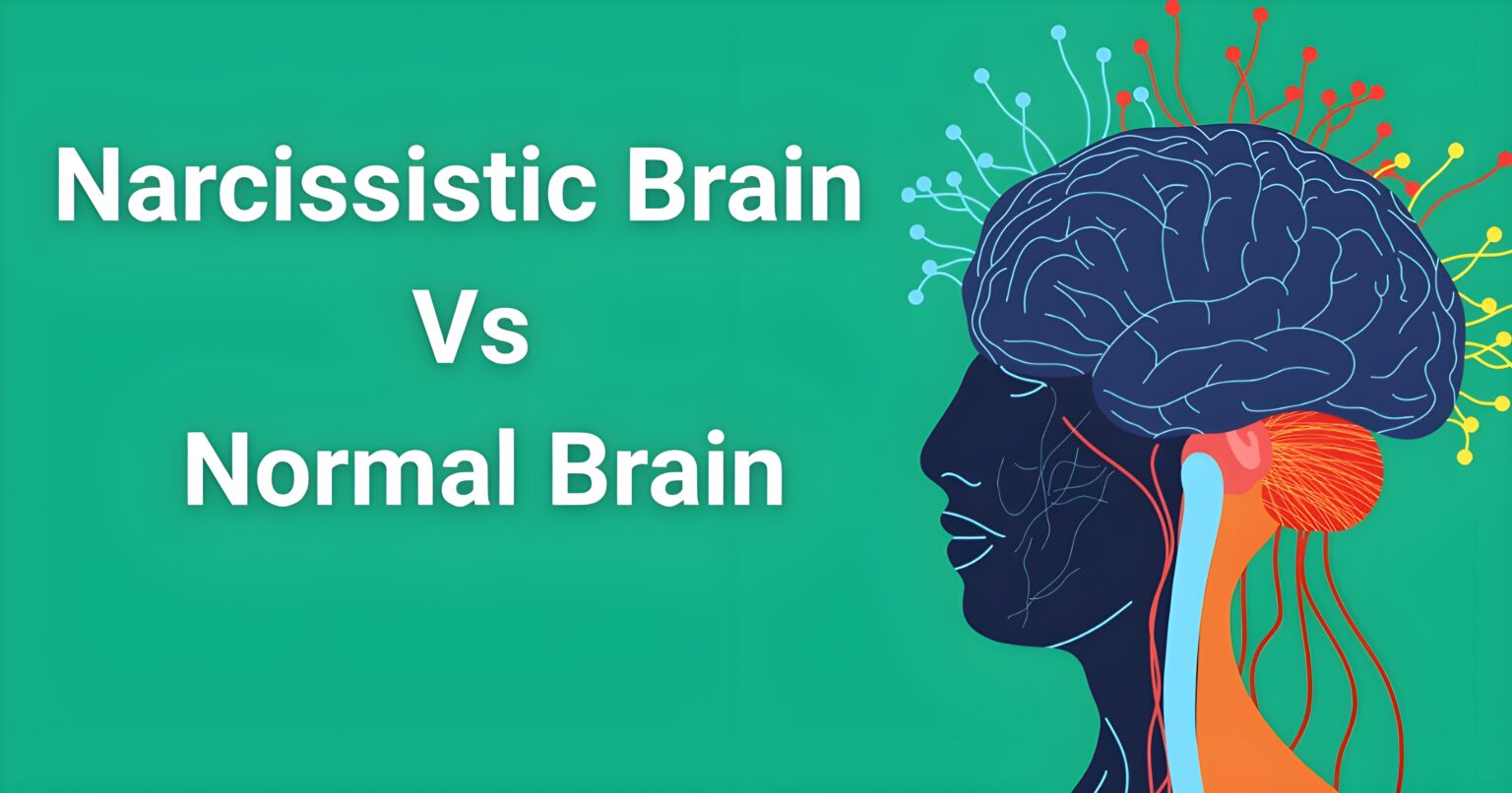Narcissistic brain vs normal brain? Mind-blowing facts are about to completely transform your understanding of why someone in your life seemed incapable of genuine empathy, authentic love, or basic human consideration. After working with thousands of survivors through NarcissismExposed.com as a Certified Narcissistic Abuse Specialist, I can tell you that discovering these neurological differences will either provide the validation you’ve desperately needed or shatter any remaining hope that they could change into the person you thought they were.
- Understanding the Healthy Brain: Your Foundation for Comparison
- The Narcissistic Brain: Structural Abnormalities That Explain Everything
- Functional Differences: How Narcissistic Brains Process Information
- Memory and Reality Processing: Why They Remember Differently
- The Stress Response System: Why They React So Extremely
- Implications for Relationships: Why Connection Is Impossible
- The Validation You’ve Been Seeking: Your Experiences Make Scientific Sense
- Recovery and Moving Forward: Using This Knowledge for Healing
- Key Takeaways: The Life-Changing Science You Need to Remember
- Frequently Asked Questions
The mind-blowing truth is that narcissistic brains are structurally and functionally different from healthy brains in ways that make genuine empathy, emotional connection, and selfless love neurologically impossible. This isn’t about choice, willpower, or moral character—it’s about fundamental differences in brain architecture that create the disturbing behaviors you witnessed.
When you understand the narcissistic brain vs normal brain differences, everything suddenly makes sense. Their inability to truly apologize, their lack of genuine remorse, their confusion when you expressed hurt, and their constant need for validation aren’t personality flaws that therapy can fix—they’re the inevitable result of brains that process reality, emotions, and relationships in fundamentally different ways.
These aren’t subtle differences that require advanced training to detect. The neurological distinctions between narcissistic and healthy brains are so pronounced that researchers can identify them through brain imaging, creating a scientific foundation that validates every confusing, painful interaction you experienced with your narcissistic abuser.
Understanding the Healthy Brain: Your Foundation for Comparison
Before we explore the shocking differences in narcissistic brain vs normal brain functioning, we need to establish how healthy brains process emotions, relationships, and social connections. This foundation will help you understand why narcissistic behavior feels so alien and disturbing to people with normal neurological functioning.
In healthy brains, emotional processing involves a sophisticated network of interconnected regions that work together to create genuine empathy, authentic emotional responses, and meaningful social connections. Understanding this normal functioning helps explain why interactions with narcissists feel so fundamentally wrong and exhausting.
The Empathy Network in Normal Brains
Healthy brains contain what neuroscientists call the “empathy network”—a collection of brain regions that automatically activate when we encounter others’ emotions. This network includes the anterior cingulate cortex, the insula, and the temporoparietal junction, which work together to help us understand and share others’ emotional experiences.
When you see someone in pain, your empathy network automatically fires, creating a physiological response that mirrors their distress. This isn’t conscious decision-making—it’s an automatic neurological response that makes you genuinely care about others’ wellbeing. Your brain literally feels a version of their pain, motivating you to provide comfort or assistance.
This empathy network also includes mirror neurons, specialized cells that fire both when you perform an action and when you observe someone else performing the same action. These neurons help you unconsciously mimic and understand others’ emotions, creating the foundation for genuine emotional connection and social bonding.
Emotional Regulation in Healthy Brains
Normal brains have well-developed prefrontal cortex regions that manage emotional responses, impulse control, and long-term thinking. This allows healthy individuals to experience emotions fully while maintaining appropriate responses and considering the impact of their actions on others.
When you feel angry, disappointed, or hurt, your prefrontal cortex helps you process these emotions without lashing out destructively. You can acknowledge your feelings while maintaining empathy for others and making decisions based on long-term consequences rather than immediate emotional impulses.
Healthy emotional regulation also involves the ability to self-soothe and recover from negative emotions without requiring others to manage your emotional state. Your brain has built-in mechanisms for processing disappointment, criticism, or failure without experiencing them as threats to your entire identity.
Social Connection Processing in Normal Brains
In healthy individuals, social connections activate reward centers in the brain, but these rewards come from genuine mutual care rather than domination or control. The release of oxytocin during positive social interactions creates feelings of bonding and attachment that motivate continued care for others’ wellbeing.
Your brain processes social relationships as opportunities for mutual support, growth, and genuine connection. You feel satisfied when others are happy, even when their happiness doesn’t directly benefit you. This creates the foundation for healthy relationships based on mutual respect and authentic care.
Understanding these normal brain functions helps explain why narcissistic brain vs normal brain differences create such profound relationship dysfunction. When one person’s brain operates on genuine connection while the other operates on exploitation and control, the mismatch creates the confusion and pain that survivors describe.
The Narcissistic Brain: Structural Abnormalities That Explain Everything
Now that we understand healthy brain functioning, let’s explore the specific structural differences that make narcissistic brain vs normal brain comparisons so revealing. These aren’t minor variations—they’re significant anatomical differences that fundamentally alter how narcissists process reality, emotions, and relationships.
Research from Harvard Medical School, published in leading neuroscience journals, reveals that narcissistic brains show consistent patterns of reduced gray matter in areas responsible for empathy and emotional regulation, while showing enlarged or hyperactive regions associated with self-focus and reward-seeking behavior.
Reduced Gray Matter in Empathy Centers
Perhaps the most significant finding in narcissistic brain vs normal brain research is the dramatically reduced gray matter in the anterior cingulate cortex and insula—the primary regions responsible for emotional empathy. This reduction can be seen clearly in brain imaging studies and explains why narcissists seem incapable of genuinely caring about others’ emotional experiences.
Think of empathy centers like the emotional processing hardware in a computer. In healthy brains, this hardware is robust and well-developed, allowing for complex emotional processing and genuine concern for others. In narcissistic brains, this hardware is significantly underdeveloped, like trying to run sophisticated emotional software on a basic computer that simply doesn’t have the processing power.
This reduced gray matter isn’t the result of trauma or environmental factors—it appears to be a developmental difference that affects brain structure from early development. Narcissists aren’t choosing to ignore others’ emotions; their brains literally have less capacity to process and respond to emotional information from others.
Enlarged Self-Referential Processing Areas
While empathy centers are underdeveloped, narcissistic brains show enlarged or hyperactive regions associated with self-referential thinking and grandiose self-perception. The medial prefrontal cortex, which processes self-related information, shows increased activity and sometimes increased volume in narcissistic individuals.
This creates brains that are essentially designed to constantly focus on themselves while having limited capacity to process others as separate, important beings. Imagine a spotlight that can only shine inward—that’s essentially how narcissistic brains process social information.
The enlarged self-referential areas also explain why narcissists interpret neutral events as being about them, why they struggle to understand others’ perspectives, and why they seem incapable of genuine selflessness. Their brains are literally wired to make everything about themselves.
Impaired Mirror Neuron Function
Research reveals that narcissistic brain vs normal brain differences include significantly impaired mirror neuron function, which explains their inability to naturally synchronize with others’ emotions or develop genuine emotional connections. Mirror neurons help healthy individuals automatically understand and share others’ emotional states, but this system functions poorly in narcissistic brains.
When you watch someone laugh, your mirror neurons fire and you automatically feel some of their joy. When you see someone in pain, your mirror neurons help you experience a version of their distress. In narcissistic brains, this automatic emotional mirroring is severely impaired, leaving them unable to naturally connect with others’ emotional experiences.
This impairment explains why interactions with narcissists feel so emotionally flat and one-sided. They’re not receiving the automatic emotional information that healthy brains process unconsciously, making genuine emotional connection neurologically impossible.
Functional Differences: How Narcissistic Brains Process Information
Beyond structural differences, narcissistic brain vs normal brain research reveals profound differences in how information is processed, decisions are made, and emotions are experienced. These functional differences explain the specific behaviors that make narcissists so difficult and painful to deal with.
Reward System Dysfunction
Narcissistic brains show hyperactive reward systems that require constant external validation to maintain basic emotional stability. The dopamine pathways that should provide internal satisfaction and contentment are dysregulated, creating an addiction-like need for admiration, attention, and superiority.
In healthy brains, reward systems respond to genuine accomplishments, meaningful relationships, and personal growth with appropriate levels of satisfaction. The system is balanced, allowing for contentment and internal peace between achievements.
In narcissistic brains, the reward system is like a broken thermostat that can never reach a comfortable temperature. No amount of external validation is ever enough to create lasting satisfaction, driving the constant need for more admiration, control, and superiority over others.
This dysfunction explains why narcissists can never be satisfied with normal levels of attention or respect. Their brains require increasingly intense forms of validation just to maintain basic emotional equilibrium, creating the exhausting dynamic that survivors recognize.
Emotional Processing Abnormalities
When examining narcissistic brain vs normal brain responses to emotional stimuli, researchers have found that narcissists process emotions in fundamentally different ways that prioritize self-protection over genuine emotional experience. Their brains show unusual patterns when viewing others in distress, with reduced activation in empathy centers and increased activation in areas associated with threat assessment.
When healthy individuals see someone in pain, their brains automatically respond with empathy and concern. When narcissists see the same situation, their brains primarily assess whether the other person’s distress threatens their own interests or image.
This explains why narcissists seem confused or annoyed when you express emotional needs rather than responding with natural concern and support. Their brains are processing your emotions as potential threats to their stability rather than as opportunities for connection and care.
Decision-Making Pattern Differences
Narcissistic brain vs normal brain differences extend to decision-making processes, where narcissists show patterns consistent with short-term thinking, impulse control problems, and inability to genuinely consider long-term consequences for others. The prefrontal cortex regions responsible for complex decision-making and moral reasoning show altered functioning in narcissistic individuals.
Healthy brains naturally consider multiple perspectives when making decisions, weighing the impact on various people and considering long-term consequences. The decision-making process includes automatic consideration of how choices will affect others’ wellbeing.
In narcissistic brains, decision-making is heavily weighted toward immediate personal benefit with limited genuine consideration for others’ needs or long-term relationship consequences. This isn’t conscious selfishness—it’s the natural result of brains that process social information primarily through the lens of personal advantage.
Memory and Reality Processing: Why They Remember Differently
One of the most confusing aspects of dealing with narcissists is how they seem to remember events completely differently than you do. Understanding narcissistic brain vs normal brain differences in memory formation and reality processing explains why conversations about past events feel like you’re talking to someone from an alternate universe.
Self-Serving Memory Bias
Narcissistic brains show extreme self-serving memory bias, where information that supports their grandiose self-image is enhanced and stored more strongly, while information that challenges their superiority is minimized, distorted, or essentially erased from memory. This isn’t conscious lying—it’s automatic neurological processing that creates their version of reality.
When a narcissist succeeds at something, their brain processes and stores that information with enhanced detail and emotional significance. When they fail or receive criticism, their brain automatically minimizes the importance of that information and may even rewrite the memory to preserve their self-image.
This explains why narcissists can sincerely deny saying hurtful things they clearly said, or why they remember receiving praise that was never given. Their brains are literally rewriting reality to maintain psychological stability, creating genuine confusion when others remember events differently.
Emotional Memory Distortion
Research on narcissistic brain vs normal brain memory processing reveals that narcissists have difficulty accurately encoding the emotional content of interactions, particularly when those emotions don’t center on themselves. They may remember the facts of a conversation while completely missing or distorting the emotional significance for others.
When you express hurt or disappointment to a narcissist, their brain may process that interaction as criticism of themselves rather than information about your emotional experience. The memory gets stored with the emotional content of being criticized rather than the reality of someone expressing their feelings.
This memory distortion explains why narcissists seem genuinely confused when you reference past emotional conversations or why they remember your expressions of pain as attacks on them. Their brains are incapable of accurately processing and storing emotional information that doesn’t directly relate to their self-image.
Reality Construction vs. Reality Perception
Perhaps the most mind-blowing aspect of narcissistic brain vs normal brain differences is how narcissists construct reality rather than simply perceiving it. Healthy brains work to accurately perceive and respond to external reality, while narcissistic brains actively construct a version of reality that supports their psychological needs.
This construction process happens automatically and unconsciously. Narcissists aren’t consciously deciding to lie or manipulate—their brains are automatically filtering, editing, and reframing information to create a version of reality where they remain superior, blameless, and deserving of admiration.
Understanding this difference is crucial for survivors because it explains why logical arguments, evidence, or appeals to fairness don’t work with narcissists. You’re operating from actual reality while they’re operating from a constructed reality designed to protect their grandiose self-image.
The Stress Response System: Why They React So Extremely
Another crucial aspect of narcissistic brain vs normal brain differences involves how these two brain types respond to stress, criticism, and perceived threats. Understanding these differences explains why narcissists react with such extreme emotion to situations that healthy individuals handle with relative calm.
Threat Detection Hypersensitivity
Narcissistic brains show hyperactive threat detection systems that interpret neutral or mildly challenging situations as serious threats to their identity and survival. The amygdala, responsible for threat detection, is often hypervigilant in narcissists, constantly scanning for potential challenges to their grandiose self-image.
When someone disagrees with a narcissist or offers constructive criticism, their brain processes this as a serious threat rather than normal social interaction. This explains why they react with such intensity to feedback that healthy individuals would consider minor or helpful.
In healthy brains, the threat detection system is calibrated to respond appropriately to actual dangers while remaining calm during normal social challenges. You can receive feedback, experience disappointment, or face criticism without your brain interpreting these experiences as threats to your fundamental identity or safety.
Stress Hormone Dysregulation
Research on narcissistic brain vs normal brain stress responses reveals significant dysregulation in cortisol and other stress hormone systems. Narcissists often maintain chronically elevated stress hormone levels and show extreme spikes in response to perceived threats to their image or control.
This dysregulation explains why narcissists seem to live in a constant state of agitation and why they create so much drama in their relationships. Their brains are literally operating from a stress state most of the time, making calm, rational responses to normal life challenges nearly impossible.
The chronic stress state also affects their ability to form secure attachments or maintain stable relationships. When your brain is constantly in threat-detection mode, other people become potential sources of danger rather than opportunities for connection and support.
Recovery and Resilience Differences
Perhaps most importantly, narcissistic brain vs normal brain differences extend to recovery from stress and the ability to bounce back from challenges. Healthy brains have robust systems for returning to baseline after stressful experiences and for learning from difficult situations.
Narcissistic brains struggle with recovery because they cannot process challenging experiences in ways that allow for genuine learning and growth. Instead of recovering from setbacks, they often become stuck in cycles of blame, resentment, and fantasies of revenge or vindication.
This explains why narcissists seem unable to learn from their mistakes or grow from difficult experiences the way healthy individuals do. Their brains lack the neurological infrastructure necessary for genuine self-reflection and positive adaptation to challenges.
Implications for Relationships: Why Connection Is Impossible
Understanding narcissistic brain vs normal brain differences helps explain why genuine emotional connection with narcissists is neurologically impossible, despite their ability to perform intimacy convincingly during certain periods. These brain differences create fundamental incompatibilities that cannot be overcome through therapy, love, or understanding.
The Attachment System Dysfunction
Narcissistic brains show significant dysfunction in the attachment systems that allow healthy individuals to form secure, lasting bonds with others. The neurological infrastructure for genuine attachment—including oxytocin release, empathy activation, and long-term bonding—functions abnormally in narcissistic individuals.
When healthy individuals form relationships, their brains release oxytocin and other bonding chemicals that create genuine attachment and motivation to care for their partner’s wellbeing. This creates relationships where both people’s happiness and security matter equally.
In narcissistic brains, the attachment system is primarily focused on securing narcissistic supply rather than creating mutual bonds. They may experience something that feels like attachment, but it’s based on what others provide them rather than genuine care for others’ wellbeing.
Communication Processing Differences
Research on narcissistic brain vs normal brain communication processing reveals that narcissists and healthy individuals are literally processing conversations differently at the neurological level. This explains why communication with narcissists feels so frustrating and futile.
When you express emotions, needs, or concerns to a healthy person, their brain automatically processes this information through empathy centers and considers how to respond supportively. The conversation flows naturally because both brains are working toward mutual understanding and connection.
When you communicate with a narcissist, their brain is primarily processing your communication through the lens of how it affects their self-image, threatens their control, or provides opportunities for manipulation. They’re not participating in the same type of communication you think you’re having.
The Empathy Gap That Cannot Be Bridged
The most significant implication of narcissistic brain vs normal brain differences is the empathy gap that makes genuine emotional connection impossible. This isn’t about learning better communication skills or finding the right approach—it’s about fundamental neurological incompatibility.
Your brain naturally seeks mutual empathy, understanding, and emotional reciprocity in relationships. You assume others can access the same emotional experiences you have because that’s how healthy brains function.
Narcissistic brains cannot provide genuine empathy because they lack the neurological infrastructure necessary for feeling others’ emotions. They can learn to mimic empathetic responses, but they cannot experience the genuine emotional concern that healthy relationships require.
This understanding is both devastating and liberating for survivors. It’s devastating because it confirms that the connection you hoped for was neurologically impossible. It’s liberating because it removes the burden of trying to create something that biology makes impossible.
The Validation You’ve Been Seeking: Your Experiences Make Scientific Sense
For survivors questioning their experiences with narcissistic individuals, understanding narcissistic brain vs normal brain differences provides the scientific validation that your confusing, painful experiences were real and not your fault. Your instincts about something being fundamentally wrong were neurologically accurate.
Why Your Intuition Was Right
Your brain’s natural empathy and emotional processing systems were correctly identifying that something was seriously wrong with how the narcissist processed emotions and relationships. The uncanny valley feeling you experienced—sensing that something was “off” despite their apparent normalcy—was your healthy brain detecting neurological abnormalities.
When you felt like you were talking to a wall during emotional conversations, you were correct. Their brains were literally not processing your emotional communication the way healthy brains would. When you felt like they didn’t really “see” you as a person, your instinct was neurologically accurate.
The exhaustion you felt from trying to connect with them makes perfect sense when you understand narcissistic brain vs normal brain differences. You were expending enormous energy trying to create emotional connection with someone whose brain was incapable of providing genuine reciprocity.
Why Nothing You Tried Worked
Understanding these brain differences explains why none of your attempts to improve the relationship succeeded. You were using strategies designed for healthy brains—clear communication, emotional honesty, compromise, and appeal to empathy—on a brain that processes information fundamentally differently.
When you explained how their behavior hurt you, their brain processed this as criticism rather than emotional information. When you tried to compromise, they saw this as weakness rather than collaboration. When you appealed to their empathy, you were asking them to use neurological systems that don’t function properly.
This isn’t your failure—it’s neurological incompatibility. No amount of love, understanding, or therapeutic intervention can bridge the gap between fundamentally different brain architectures.
The Science Behind Your Trauma Response
Your trauma responses to narcissistic abuse also make scientific sense when viewed through the lens of narcissistic brain vs normal brain differences. Your healthy brain was constantly trying to process interactions that violated basic assumptions about human emotional connection and empathy.
The confusion, self-doubt, and emotional exhaustion you experienced were normal responses to sustained interaction with abnormal brain functioning. Your brain was working overtime trying to understand behavior that doesn’t follow normal human emotional patterns.
The relief many survivors feel when learning about these brain differences reflects their brain’s need for coherent understanding of their experiences. Your cognitive dissonance resolves when you understand that you weren’t dealing with a healthy brain that chose to be cruel—you were dealing with a brain that processes reality differently at the most fundamental level.
Recovery and Moving Forward: Using This Knowledge for Healing
Understanding narcissistic brain vs normal brain differences isn’t just academic knowledge—it’s a powerful tool for healing and moving forward in your recovery journey. This scientific foundation helps you process your experiences and build healthier relationships based on realistic expectations about human neurological diversity.
Releasing Self-Blame and Guilt
Perhaps the most healing aspect of understanding these brain differences is the complete release from self-blame that becomes possible. When you understand that narcissistic behavior stems from fundamental neurological differences rather than choices or moral failings, you can stop taking their treatment of you personally.
Their inability to love you genuinely, empathize with your pain, or prioritize your needs wasn’t about your worthiness or lovability. It was about their neurological incapacity for the type of emotional connection you naturally seek and deserve.
This knowledge helps you understand that no version of yourself would have been able to create the connection you sought. The problem was never with you—it was with the fundamental mismatch between your healthy brain seeking genuine connection and their brain operating from self-focused neurological programming.
Building Future Relationship Skills
Knowledge of narcissistic brain vs normal brain differences helps you develop better skills for identifying healthy relationship partners and avoiding similar dynamics in the future. You now understand what genuine empathy, emotional reciprocity, and healthy attachment look like at the neurological level.
Healthy partners will demonstrate consistent empathy that doesn’t disappear when they’re stressed or when your needs conflict with their preferences. Their emotional responses will be proportional to situations and their memory of emotional conversations will be accurate and considerate.
You can now recognize the difference between performed empathy and genuine empathy by understanding the neurological basis of authentic emotional connection. This knowledge helps you trust your instincts when something feels emotionally flat or manipulative in future relationships.
Understanding Your Own Healing Process
The trauma symptoms you’ve experienced make sense when viewed through the lens of your healthy brain trying to process interaction with abnormal brain functioning. Your confusion, hypervigilance, and emotional dysregulation were normal responses to abnormal stimuli.
Understanding this helps you approach your healing with compassion for the neurological stress you endured. Your brain was doing its best to maintain emotional equilibrium while dealing with someone whose brain couldn’t provide the reciprocity and consistency that healthy relationships require.
Recovery involves helping your healthy brain return to normal functioning after the stress of trying to connect with incompatible neurological systems. This process takes time and often professional support, but understanding the scientific basis of your experiences provides a roadmap for healing.
Key Takeaways: The Life-Changing Science You Need to Remember
Understanding narcissistic brain vs normal brain differences—these mind-blowing facts about neurological structure and function—provides the scientific foundation you need to process your experiences and move forward with confidence in your perceptions and choices.
Remember these crucial scientific insights:
- Narcissistic brains have reduced gray matter in empathy centers making genuine emotional connection neurologically impossible, not a choice
- Their enlarged self-referential processing areas create brains designed to focus on themselves while having limited capacity to process others as important
- Impaired mirror neuron function explains their inability to naturally synchronize with others’ emotions or develop authentic emotional bonds
- Hyperactive reward systems require constant external validation creating addiction-like needs for admiration and control that can never be satisfied
- Memory processing differences mean they literally remember events differently, creating their own version of reality rather than perceiving actual reality
- Stress response hypersensitivity makes them interpret normal feedback as serious threats, explaining their extreme reactions to minor challenges
The healing truth about narcissistic brain vs normal brain differences:
- Your confusion and exhaustion were normal responses to abnormal brain functioning
- Nothing you tried failed because of your inadequacy—it failed because of neurological incompatibility
- Their treatment of you reflected their brain limitations, not your worthiness of love
- Genuine empathy and emotional connection require neurological systems they simply don’t possess
- Understanding these differences protects you from future relationships with similar dysfunction
- Your healthy brain seeking genuine connection is exactly how relationships should work
Understanding narcissistic brain vs normal brain differences isn’t about excusing harmful behavior or maintaining hope for change—it’s about accepting the neurological reality that explains your experiences and validates your decision to prioritize your own emotional wellbeing. When someone asks about these mind-blowing facts, they’re seeking scientific validation for experiences that challenged their basic assumptions about human emotional connection and empathy.
Your instincts were right, your experiences were real, and your need for genuine emotional reciprocity is both normal and achievable with neurologically healthy partners who can provide the authentic connection your brain naturally seeks and deserves.
Frequently Asked Questions
Can narcissistic brain differences be treated or changed through therapy?
While therapy can help narcissists develop better behavioral control and social skills, it cannot fundamentally change the structural brain differences that create narcissistic functioning. The reduced gray matter in empathy centers, enlarged self-referential processing areas, and impaired mirror neuron systems represent permanent neurological architecture. Therapy might help them learn to better mimic appropriate responses or control harmful behaviors, but it cannot create the genuine empathy and emotional connection that healthy relationships require. Some improvement in functioning is possible, but the core neurological limitations remain unchanged.
Does understanding these brain differences mean narcissists aren’t responsible for their harmful behavior?
Understanding neurological differences provides context for narcissistic behavior but doesn’t eliminate personal responsibility for choices and actions. While narcissists may have limited capacity for genuine empathy, they typically understand social rules and consequences well enough to control their behavior when it serves their interests. Many narcissists can behave appropriately in professional settings or with people they want to impress, demonstrating that they have some behavioral control. The brain differences explain their limitations but don’t excuse harmful choices or eliminate the need for consequences and boundaries.
Are these brain differences present from birth or do they develop due to childhood trauma?
Current research suggests narcissistic brain differences likely result from a combination of genetic predisposition and early developmental factors, rather than being purely caused by childhood trauma. While trauma can certainly influence development, many people experience significant childhood trauma without developing narcissistic brain patterns. The structural differences appear to be neurodevelopmental, meaning they form during early brain development rather than being acquired later through experience. However, environmental factors during critical developmental periods may influence how these genetic predispositions are expressed.
Can brain scans definitively diagnose narcissistic personality disorder?
While brain imaging studies consistently show patterns associated with narcissistic traits, brain scans are not currently used for clinical diagnosis of narcissistic personality disorder. Diagnosis still relies on behavioral criteria and clinical assessment by qualified mental health professionals. The brain differences are statistically significant across groups but may not be distinct enough in individual cases to serve as diagnostic tools. However, this research provides valuable validation for the experiences of those who’ve dealt with narcissistic individuals and helps explain why certain behaviors are so consistent across narcissistic personalities.
Do all people with narcissistic traits have these same brain differences?
The severity of brain differences generally correlates with the severity of narcissistic traits, but there’s likely a spectrum of neurological variation. People with clinical narcissistic personality disorder show the most pronounced brain differences, while those with subclinical narcissistic traits may have less severe but still noticeable patterns. Additionally, different subtypes of narcissism (grandiose vs. vulnerable) may show somewhat different neurological profiles. The research continues to evolve as scientists better understand the relationship between brain structure, function, and narcissistic behavior patterns.
Does this mean I should feel sorry for narcissists because of their brain limitations?
Understanding neurological differences can help you process your experiences without taking their behavior personally, but it doesn’t obligate sympathy or continued relationship investment. Many people have neurological differences or limitations without causing harm to others. The key is that narcissists typically show little genuine motivation to manage their limitations or minimize harm to others. Your compassion and energy are better directed toward your own healing and toward relationships with people who demonstrate genuine care for your wellbeing, regardless of their neurological starting point.
How can I use this knowledge to protect myself in future relationships?
Understanding narcissistic brain vs normal brain differences helps you recognize authentic empathy and emotional reciprocity in potential partners. Look for consistent empathy that doesn’t disappear during stress, proportional emotional responses, accurate memory of emotional conversations, and genuine consideration for your wellbeing even when it conflicts with their preferences. Trust your instincts when something feels emotionally flat or performed rather than authentic. Most importantly, prioritize partners who demonstrate sustained behavioral evidence of empathy and emotional reciprocity rather than just verbal expressions of care or dramatic emotional displays that might be neurologically shallow.






